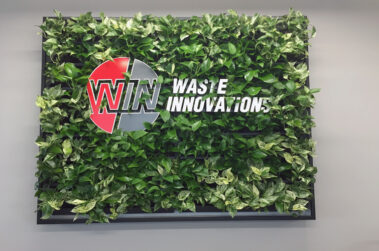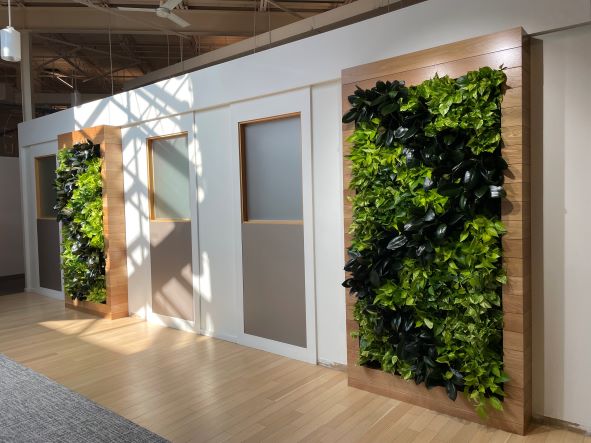Living walls and green walls explode with variegated green plants and textures creating a wall of art! It is a fantastic biophilic design solution. Living walls bring the intrinsic benefits of nature into the interior environment while transforming everyday spaces into distinct, interior experiences.
Design and Economics
Living walls are trending as a means for branding. The green design is a canvas for incorporating a company name or logo. Walls provide an empty canvas to add texture and color using green plants in multiple ways. Green walls can be installed almost anywhere and benefit every type of industry. Living wall systems are designed to attach to an existing structure, integrated into an entirely new development, or can be free-standing.
The added value of greenery in the environment:
- Building lobbies: increased property value, perceived luxury, and improved corporate image
- Office environments: noise reduction, cleaner air, improved concentration, increased productivity for employees
- Health care facilities: reduced recovery time for patients. Published studies indicate biophilic elements as the primary influencers for faster recovery rates, decreased dependency on medication, improved emotional wellness
- Educational facilities: increased focus on task and improved concentration. Students commented on the green wall installed in their university common area, “The breathing wall relaxes them and helps them focus on their studying.”
- Condominiums and apartments: attractive to new buyers and maintains existing renters
- Hospitality: perceived as clean, fresh, and luxury accommodations
- Restaurants: project an organic freshness and healthy eating
Features
- A well-designed living wall achieves both design and functional objectives
- Has a long lifespan
- Requires minimal component replacement
- Has achievable demands for maintenance
Design Process
- We help you select the best system and plants for the area
- We create a design for the specific space with consideration of lighting and airflow
Please contact us to inquire about a living wall installation.
Fundamentals of living wall installations
Lighting
Plants need bright light to thrive. Bright light also allows for a broader plant species selection including attractive chartreuse (bright green) and variegated plants.
- Light Intensity > 150 Foot Candles (1500 lux)
- Color Temperature =+4,300-5,500 to produce healthy plants
- Lighting should produce an even distribution “flooding” the wall
- LED lighting is recommended
- A minimum of a six-foot distance from the wall is recommended
- A timer is required and set for 12 hours on and 12 hours off. Plants need rest too!
Light Distribution
- Lighting should be evenly distributed flooding the wall without “hot spots” and “cold spots” and is vital to the success of the living wall
- Uneven lighting alters water requirements of the various plants in the wall causing maintenance issues and decreased plant health
Water
Everyone knows that p lants need water to survive. There are two types of irrigation systems: recirculating irrigation and direct irrigation, as well as manual irrigation.
lants need water to survive. There are two types of irrigation systems: recirculating irrigation and direct irrigation, as well as manual irrigation.
- Recirculating Irrigation Systems: As the name implies, this system recirculates water through the living wall. The water source is a manually filled irrigation tank located underneath the wall. Water is pumped to the top of the vertical garden where it trickles down to the plants throughout the wall. Excess water drains into the tank to be recirculated. This system is typically used for smaller living walls.
- Direct Irrigation Systems: Direct irrigation systems are slightly more complex. Unlike a recirculating system, there is no water tank or pump. Water, usually from a city water line, is channeled to the living wall via water pressure. This system can also include a water filter and fertilizer injections. Excess water trickles down to the plants throughout the wall and sent down a drain. This system is typically used in larger living walls that require more water and allows for an ongoing, uninterrupted supply of hydration.
- Manual Irrigation: Manual irrigation involves watering by hand. Using a water machine, a watering can, or hose, it is used to care for small-scale living walls.
Ultimately, the amount of water necessary to keep your living wall alive depends on the requirements of the type and number of plants used. Like most structures, irrigation systems require periodic inspections to make sure everything is working correctly and efficiently.



 lants need water to survive. There are two types of irrigation systems: recirculating irrigation and direct irrigation, as well as manual irrigation.
lants need water to survive. There are two types of irrigation systems: recirculating irrigation and direct irrigation, as well as manual irrigation.














